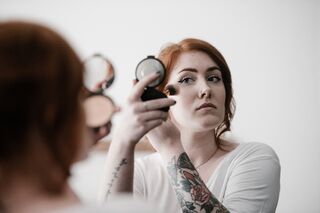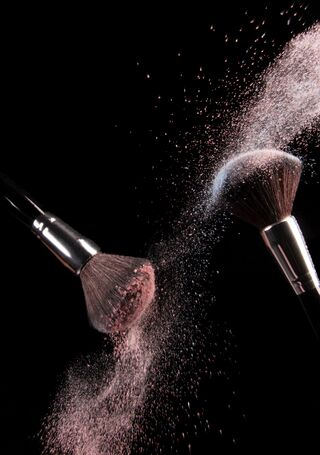Beauty
The Big Cover Up: Why We "Need" Makeup and What We're Not Told
Cosmetics can have dangerous chemicals. But what's wrong with our naked faces?
Posted July 12, 2022 Reviewed by Michelle Quirk
Key points
- Chemicals found in cosmetics (and sunscreen) are largely unregulated.
- While consumer protection agencies need to step up to protect us, we can think more about what we use on our skin and why.
- We can develop confidence and self-acceptance without the risks of the most harmful makeup.

Using face and body makeup is a custom that dates back to very early—and very many—civilizations. From ancient Egypt to Native American and Pacific Island traditions to European salons, we humans seem to like to apply and re-apply.
According to statistics from 2017, 30 to 40 percent of people in the United States—mostly women—use makeup daily, with many more using it less frequently.
In 2020, one survey noted that 107 million women in the United States regularly used foundation or concealer make-up.
Why People Use Makeup
Some like using makeup as a fun way of expressing themselves artistically, seeing the face as a "canvas." Other people believe it's just what you "must do" to "fix imperfections." I've heard many people, mostly women, confess they just can't be seen in public without it.
When things make us feel better about ourselves or are outlets for fun or creative expression, we see that as positive.
Ugly Truths About Makeup
But in the case of makeup, we have to go deeper. There are some very ugly truths about makeup that can cause us great harm if we don't learn the facts.
The $100-billion cosmetics industry uses roughly 10,000 unique chemical ingredients in makeup and other personal care products, and the majority of those chemicals have never been tested for safety by government regulators.1 And when it comes to many products with harmful ingredients, women of color have more exposure and are suffering health consequences at a disproportionately higher rate.
One recent study, which tested more than 200 cosmetics including concealers, foundations, and eye and lip makeup, found that 52 percent of all products tested contain high levels of per- and polyfluoroalkyl substances—PFAS—which harm the environment and have been linked to cancer, thyroid disease, low birth weight, and immunotoxicity in children.2 Alarmingly, the presence of PFAS chemicals was largely not disclosed on ingredients labels.

And makeup products often contain talc, which can contain the cancer-causing ingredient asbestos.
According to the recent HBO docuseries "Not So Pretty," people who have been using makeup and other talc-containing products for years are now suffering with mesothelioma, other cancers, and chronic diseases linked to talc and asbestos.
In 2019, the FDA advised consumers to not use certain cosmetics products from the national chain store Claire's, as they had been found to contain asbestos. The company disputed the findings but agreed to a voluntary recall—but by that point, the products had been bought and potentially used by many girls and young women across the country.
And there are thousands of other untested ingredients in cosmetics with unknown health consequences.
Sunscreen is added to many foundation and lip products, but last year the US Food and Drug Administration (FDA) acknowledged safety concerns with ingredients found in many sunscreens, including oxybenzone, octocrylene, and others. According to the FDA, the only sunscreen ingredients known to be safe are titanium dioxide and zinc oxide. (A consumer protection guide to sunscreens can be found here.)
Other serious dangers lie in skin bleaching products sometimes used by women of color. These products can contain mercury and hydroquinone, known to be highly toxic and dangerous to the nervous system, immune system, and vital organs. Sadly, women of color in the United States and globally have long been subject to racism, colorism, classism, and the effects of colonialism, which impart the terrible and entrenched bias that lighter skin is better than darker skin.
Amira Adawe, Founder of the Beautywell Project believes it's essential, but not easy, to promote change. "My dream is that every woman stops using skin-lightening creams and trying to change their color,” she said, "and that they are happy for who they are.”
In the United States, the last significant law aiming to regulate general cosmetics safety is from 1938, a time when most ingredients in today's makeup didn't even exist.
Basically, "if you're a user of cosmetics today in the U.S., you're at risk," says Jamie McConnell of Women's Voices for the Earth, a co-founder of the growing Campaign for Safe Cosmetics.
Last year, Congresswoman Jan Schakowsky of Illinois, who has been working on beauty and personal care product safety since 2010, introduced the Safer Beauty bills package into Congress.
If passed, the package of legislation would do many things to protect consumers (and workers), including ensuring some of the most toxic chemicals are banned from beauty products and requiring disclosure of ingredients not required now (such as under the blanket term "fragrance"). Also, it would help protect beauty and nail salon workers from a toxic work environment.
"It's time the U.S. give[s] consumers the confidence that their beauty and personal care products are safe," says Rep. Schakowsky.
Maybe it's also a good time to ask ourselves how attached we are to coating and changing our faces and why?
Our Beauty "Standards"
While the urge to look attractive may be in our DNA, our brains have a say, too. Certainly, we want to look attractive, but attractiveness is defined by the culture of our times. And, of course, the media shows us highly made up, often artificially smoothed or lightened images, especially of women and girls, millions of times a day. All that repetition forges thoughts in our minds about our own appearance and how we "should" look—setting up "standards" for our appearance—consciously or not.
With our social-media-driven love of selfies and videoing ourselves, many people desire a super-sleek, made-up image to mimic what we see so often. Also, remote work and play via Zoom and FaceTime can increase the pressure to have what we see as an "on-camera look," including makeup.
And let's not forget, playing with makeup can be just fun too!
But chronic and fatal diseases are not. It's time to ask ourselves, how far will we go to keep up with the image of beauty we are shown? Are our naked faces really so bad? And if we think so, what does that say about our ability to truly love our natural and whole selves?
Protecting Ourselves
We can and should be legitimately angry that the government isn't protecting us and about centuries of racial discrimination, as well as the repetition of homogenous, sales-driven media images. But, as of right now, it's officially on us to make decisions to protect our own bodies and those of our children.
- We can let elected officials know that we want our health taken seriously and that the government needs to regulate dangerous chemicals.
- We can buy clean beauty products (but can't assume that more expensive products are inherently "cleaner," or that just because a product claims to be "natural," it really is). Online databases, such as Skin Deep from the Environmental Working Group, along with others, can be helpful to identify potentially dangerous ingredients in makeup and find safer, cleaner products.
- We can go incremental, reducing the number of products we use or the frequency with which we use them, saving and redirecting our money as well.
- We can also choose radical self-esteem and accept and like our own unique faces as they are, knowing that what's inside our skin is what will really make us happy and strong and keeps us going for the long run.
References
1. https://schakowsky.house.gov/media/press-releases/schakowsky-announces-…
2. (PFAS are known as "forever chemicals" as they dont break down easily in the environment or our bodies, lasting thousands of years; every American tested has PFAS in their bloodstream. https://www.cleanwateraction.org/features/pfas-forever-chemicals#:~:tex…




